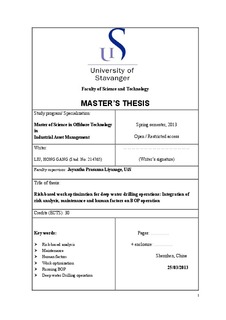| dc.description.abstract | The offshore deep water drilling has attracted global attention since the Macando blowout. It raised worldwide concern on the safety level of oil & gas industry and resulted in directly influence on offshore drilling activity. The thesis start from the introduction of offshore drilling, and the development of global oil & gas market, then come back to China, and generally described the history of offshore petroleum exploration and production in South China Sea and the deep water activity. Then this thesis centered on the offshore deep water drilling process, cooperated with the general work flow of drilling operation on COSL’s 1st deep water drilling unit HYSY981 to build up a general work flow map. Identify the critical activities from risk prospective, clarify the risk level of different activity and find out the related issues that contribute to the risk and efficiency by using different kind of risk analysis tools.
The thesis starts from the background of the offshore drilling industry, and introduces current situation and developing trends of offshore deep water drilling. Then the author turns his sight into China and introduces the development process of China offshore petroleum industry.
In the following chapter is the theoretical basis of further study. This part discusses drilling risk, maintenance activities, human factors and work optimization, and develops the relationship of them.
Use the risk analysis tool, bow-tie diagram and risk matrix, related to the practical operation on the rig, the work flow map is used and choose running/pulling BOP as a specific activity to do further study. Using of the concept of integration of risk analysis, equipment maintenance activities, and human factors to improve the safety level and operation performance.
I will conclude from the discussion, and come back to the very basic point: safety and performance issue. By describing the implementation of risk analysis, maintenance activities, and human factors in BOP operation, we could explore their contribution to work optimization and how do they impact on the operation. The author still introduces the success factors and stimulus for work optimization, and then briefly concludes the work optimization points on running/pulling BOP operation.
At last, we will provide two simple cases that have been implemented on the rig. Basic risk analysis tools and minor modification has significant contribution on safety and work performance. | no_NO |
